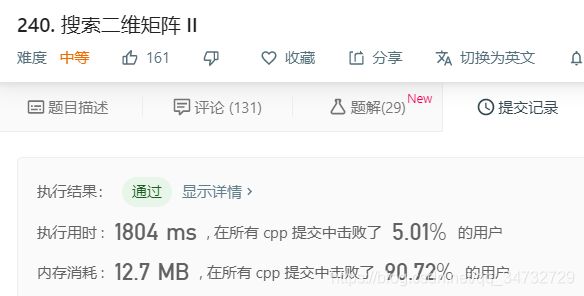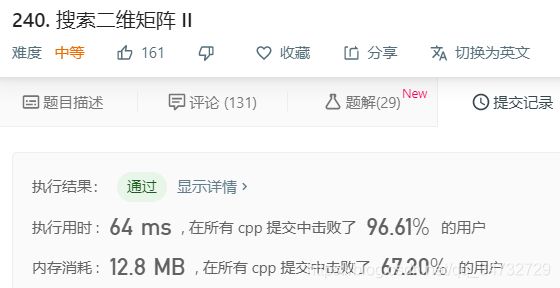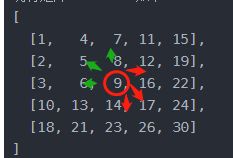LeetCode——240 搜索二维矩阵II
问题描述:
编写一个高效的算法来搜索 m x n 矩阵 matrix 中的一个目标值 target。该矩阵具有以下特性:
每行的元素从左到右升序排列。
每列的元素从上到下升序排列。
示例:
现有矩阵 matrix 如下:
[
[1, 4, 7, 11, 15],
[2, 5, 8, 12, 19],
[3, 6, 9, 16, 22],
[10, 13, 14, 17, 24],
[18, 21, 23, 26, 30]
]
给定 target = 5,返回 true。
给定 target = 20,返回 false。来源:力扣(LeetCode)
链接:https://leetcode-cn.com/problems/search-a-2d-matrix-ii
著作权归领扣网络所有。商业转载请联系官方授权,非商业转载请注明出处。
执行结果:
1、递归执行结果:↓
2、更优方案划执行结果:↓
代码描述:
1、递归方式描述:
当取到的中间值,比目标值大或者小时,有三个方向需要进行比较。就像二叉树和三叉树一起的故事。
添加memary,访问过的就不再访问,可以减少递归深度,提高效率。但是,还没有想到办法。
class Solution {
int m,n; // 保存矩阵的行数和列数
public:
bool searchMatrix(vector>& matrix, int target) {
if(matrix.size()==0 || matrix[0].size() == 0)
return false;
m = matrix.size(), n = matrix[0].size();
int x1 = 0, y1 = 0, x2 = m-1, y2 = n-1;
bool ans = false;
return search(matrix,target,x1,y1,x2,y2,ans); // 运用递归
}
bool search(vector> &matrix, int &target, int x1, int y1, int x2, int y2, bool &ans) // ans为引用
{
if(ans)
return true;
if(x1>x2 || y1>y2 || x1<0 || x1>=m || x2>=m || y1<0 || y1>=n || y2>=n)//两头不越界,中间不越界
return false;
int mx = x1+((x2-x1)>>1);
int my = y1+((y2-y1)>>1);
if(matrix[mx][my] == target)
{
ans = true;
return ans;
}
if(matrix[mx][my] < target)
{
search(matrix,target,x1,my+1,mx,y2,ans)
|| search(matrix,target,mx+1,y1,x2,my,ans)
|| search(matrix,target,mx+1,my+1,x2,y2,ans);//右,下,右下
return ans;
}
else
{
search(matrix,target,x1,my,mx-1,y2,ans)
|| search(matrix,target,mx,y1,x2,my-1,ans)
|| search(matrix,target,x1,y1,mx-1,my-1,ans);//左,上,左上
return ans;
}
}
};
2、更优方法描述
将起始位置定位在左下角(右上角也可以),此时,行只能向上,值越来越小,列只能向右,值越来越大,路径沿着一条曲折的线,由左下角,走向右上角。
// 从概率的角度来算,在查找到目标值之前,一定会先处理很多大于、小于的判断。
// 所以,把==的判断放在最后。经过几次程序对比,果然这种方式用时最小。
class Solution {
int m,n;
public:
bool searchMatrix(vector>& matrix, int target) {
if(matrix.size() == 0 || matrix[0].size() == 0) return false;
int row, col;
row = matrix.size();
col = matrix[0].size();
int x = row-1;
int y = 0;
while(x >= 0 && y < col)
{
if(matrix[x][y] target)
--x;
else
return true;
}
return false;
}
}; 3、两种方法的测试:
调用主函数:
#include
#include
#include
using namespace std;
int main()
{
vector> test;
vector temp;
int NUM = 10001;
int k = 1;
for (int i = 1; i < NUM; ++i,++k)
{
for (int j = 1; j < NUM; ++j)
{
temp.push_back(j+k);
}
test.push_back(temp);
temp.clear();
}
cout << "矩阵大小为"< 结果对比:
可以看出第二种方案的优越性!!!差距如此之大!







